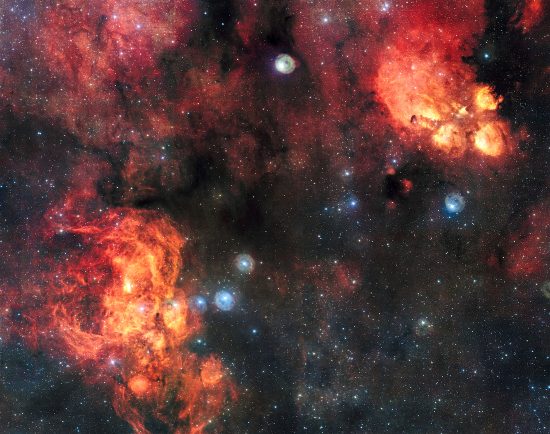
NGC 6334, upper right and NGC 6357, lower left indicate regions of star formation, including dark clouds of dust. Credit: ESO. Click to enlarge.
Apr 12, 2018
A hidden star factory.
NGC 6334 (the Cat’s Paw nebula) is also known as the Bear Claw nebula. It is 50 light-years across and approximately 5500 light-years away, using redshift distance calculations. It is part of a larger nebular complex near the heart of the Milky Way that includes NGC 6357, the Lobster nebula. The Cat’s Paw nebula is thought to be one of the most prolific stellar nurseries, with thousands of young stars.
According to a recent ESO press release, NGC 6334 contains an active star-forming region where hundreds of blue-white stars are seen. Dust in the nebulae is so thick that it obscures most of what is behind it. However, by observing at infrared wavelengths, ESO’s VISTA can peer through the dust, revealing star formation activity.
NGC 6334 would ordinarily be a brightly lit emission nebula if not for the “extinction” of blue and green light. Extinction is usually used to indicate the dimming of light in Earth’s atmosphere from a direct beam transmission. The atmosphere either absorbs light, or certain frequencies are scattered. Atmospheric scattering is the primary mechanism that dims light on Earth, but in space the main culprit is absorption: dust and clouds of molecular gas “soak up” the higher spectral bands, which are blue and green. That is the reason NGC 6334 is given a red coloration when electro-optical devices display the image.
As stated in the press release, the nebula is a prolific stellar nursery, with a potential population of new stars numbering in the thousands, although the dusty environment makes it difficult to see most of them. From an Electric Universe viewpoint, the bubble located in the lower right of the image is an interesting feature.
ESO proposes that it is a dying star ejecting its outer layers, or perhaps the expanding remnant of a star that has already exploded. However, the converging radial filaments are likely indicators of an interstellar Birkeland current that is “pinching down” in an hourglass shape. Rather than a bubble, we might instead be “looking down the barrel” of a vortex, or z-pinch.
An electromagnetic z-pinch can squeeze plasma with such force that it rapidly compresses. Electric current flowing into the z-pinch might cause the plasma to erupt in an arc-mode discharge. Plasma structures are visible in the nebulae, and they behave according to the laws of electric discharges and circuits.
Near the center of the Milky Way there is an abundance of electromagnetic energy, and it is in the most dense current flows where stars form. Stars are not born of gravitational forces, but from the electric nature of the Universe and the way that moving plasma behaves in a magnetic field.
Previous Pictures of the Day explain that an electric discharge in a plasma cloud (a nebula) can create a double layer, or sheath, along its axis. Electric charge flows along the sheath, spiraling into filaments, or double layers, which attract each other. Instead of merging they twist around into a helix, gradually pinching down into powerful electric discharges.
A star is born when those discharges reach the arc-mode state—the more intense the electric current the bluer, larger, and more energetic the star. NGC 6334 is in a highly energized state, so it is rapidly creating massive blue-white stars.
Stephen Smith












